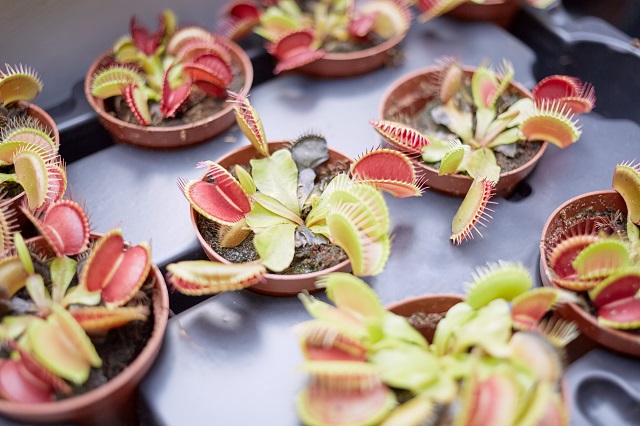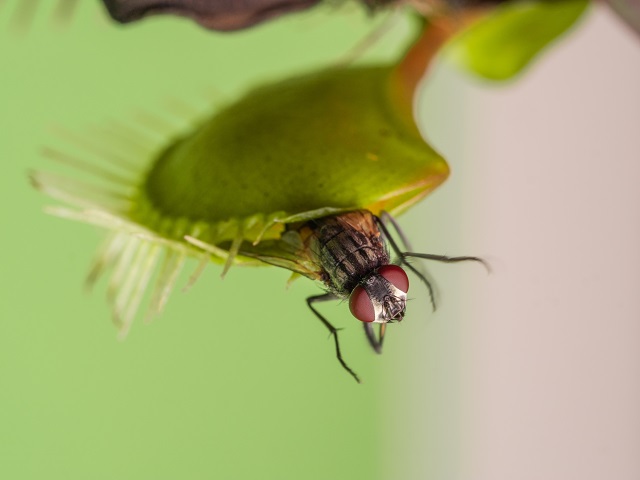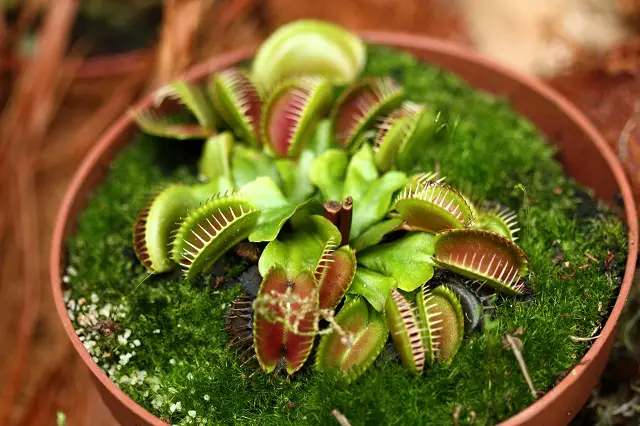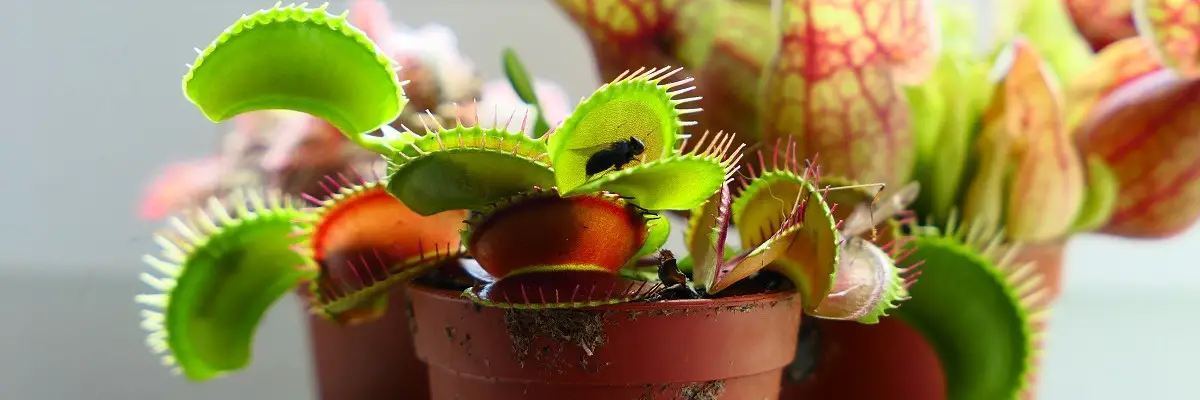How to Grow Venus Flytrap: Are you interested in cultivating a Venus flytrap in your own home? These carnivorous plants are fascinating to grow and can add a unique touch to your indoor garden. With proper care and attention, you can have a thriving Venus flytrap that will impress your friends and family.
Importance of proper care:
Proper care is essential for the health and survival of a Venus Flytrap. The Venus Flytrap is a unique and delicate plant that requires specific conditions to thrive. If the plant is not given the right amount of light, water, and food, it can become weak, stunted, or even die. Additionally, if the Venus Flytrap is not protected from pests and diseases, it can quickly become infested and succumb to illness. By providing the Venus Flytrap with the proper care, you can ensure that it lives a long and healthy life and continues to capture and digest insects in your home or garden.
Understanding the Venus Flytrap
The Venus flytrap is a carnivorous plant native to the wetlands of the southeastern United States. Its scientific name is Dionaea muscipula. The plant gets its common name from its ability to trap and digest insects, which it uses as a source of nutrition in its nutrient-poor habitat.
The Venus flytrap has small, green leaves that form a rosette shape. Each leaf has a hinge at its base and is lined with sensitive trigger hairs that detect the presence of an insect. When an insect brushes against the trigger hairs, the leaf snaps shut, trapping the insect inside. Digestive enzymes are then released to break down the insect’s body and absorb the nutrients.
Choosing the Right Growing Conditions
Cultivating a Venus flytrap in your home can be a fun and rewarding experience, but it requires providing the right growing conditions to ensure the plant thrives. Here are some tips on how to choose the right growing conditions for your Venus flytrap.
Light
Venus flytrap prefers bright, indirect light. While it can tolerate direct sunlight, it’s best to avoid placing it in a south-facing window as the intense sun can burn the leaves. A north or east-facing window is ideal, but if you don’t have one, you can provide indirect light with the help of fluorescent lights.
Temperature
Venus flytrap prefers a daytime temperature of around 70-75°F and a nighttime temperature of around 55-60°F. Protecting the plant from cold drafts and extreme heat is important to prevent damage.
Humidity
Venus flytrap prefers a humid environment. You can increase humidity by placing a water tray near the plant, misting the leaves regularly, or using a humidifier.
Soil
Venus flytrap prefers well-draining soil that is high in peat moss. This can be achieved by mixing equal parts of peat moss, perlite, and sand. It’s important to keep the soil consistently moist but not waterlogged.
Water
Venus flytrap prefers to be kept consistently moist. You can use rainwater, distilled water, or reverse osmosis water for watering Venus flytraps. Avoid using tap water as it can contain chemicals that can harm the plant.
You can ensure your Venus flytrap will thrive and grow strong by providing the right light, temperature, humidity, soil, and water. Remember also to provide a source of food for the plant, as Venus flytraps rely on trapping and digesting insects for their energy.

Feeding and Watering
How to properly water a Venus Flytrap:
Watering a Venus Flytrap properly is crucial for its survival and growth. The Venus Flytrap is a native of wetlands and bogs and prefers consistently moist soil. The best way to water a Venus Flytrap is to use distilled water or rainwater, as tap water can contain chlorine and other chemicals that can harm the plant. The Venus Flytrap should be watered until the soil is saturated, and the excess water should be drained away.
It’s important to note that Venus Flytraps can’t tolerate standing water, so make sure the soil is well-draining and the pot is equipped with drainage holes. It’s also important to be mindful of the humidity levels around the plant. Venus Flytrap prefers high humidity, so if the air in your home is dry, you may want to consider using a humidifier or placing a tray of water near the plant.
Additionally, allowing the soil to dry out slightly between watering is a good idea, as the Venus Flytrap also requires a period of dormancy. The soil should be allowed to dry out almost completely during this period. This will help the plant to rest and conserve energy.
In summary, the Venus Flytrap should be watered consistently and thoroughly but not to the point of waterlogging. Distilled or rainwater should be used, and the soil should be allowed to dry out slightly between watering to mimic the plant’s natural habitat. Keep an eye on humidity levels, and adjust as needed.
Unlike most plants, the Venus flytrap does not rely on photosynthesis for its energy. Instead, it relies on trapping and digesting insects. Therefore, it is important to provide a source of food for the plant. This can be done by placing small insects, such as fruit flies or small crickets, into the traps.
It is important to note that Venus flytraps do not require to be fed frequently; it is best to feed them no more than once a week. Overfeeding can lead to the plant expending more energy on digestion than growth.
Feeding guidelines for Venus Flytrap:
Venus Flytraps are carnivorous plants that rely on insects as a primary food source. In the wild, Venus Flytraps capture and digest small insects such as ants, flies, and spiders. Captive Venus Flytraps can be fed a variety of small, live insects such as crickets, fruit flies, or small mealworms. It’s important to note that Venus Flytraps should be fed only occasionally and not overfed. Once every 2-3 weeks is typically sufficient, and a single insect per trap is enough.
When feeding a Venus Flytrap, it’s important to be gentle and not damage the delicate trigger hairs on the traps. To feed the plant, place the insect on the trap, and wait for the trap to close. If a trap does not close, it is probably damaged and should be left alone. Once the trap has closed, the insect should be digested within a week, after which the trap will open again.
It’s also important to note that Venus Flytraps do not require feeding to survive. They can survive and even thrive without feeding if they are given the right growing conditions. If you choose not to feed your Venus Flytrap, it will still be able to survive by photosynthesizing through its leaves.
In summary, Venus Flytraps should be fed occasionally with small live insects such as crickets, fruit flies, or small mealworms. It’s important to be gentle, not damage the trigger hairs, and not to overfeed the plant. Venus Flytraps do not require feeding to survive, but it can be beneficial for the plant’s growth and health.
Common mistakes to avoid:
- Overwatering: As mentioned earlier, Venus Flytraps prefer consistently moist soil but cannot tolerate standing water. Overwatering can lead to root rot and other fungal issues that can quickly kill the plant. To avoid this, ensure the soil is well-draining and the pot has drainage holes. Allow the soil to dry out slightly between watering, and be mindful of the humidity levels around the plant.
- Overfeeding: Venus Flytraps are carnivorous plants that require insects as a primary food source, but they should be fed only occasionally and not overfed. Overfeeding can lead to the traps becoming damaged or diseased and can also lead to nutrient imbalances in the soil.
- Improper lighting: Venus Flytraps require a lot of bright, indirect light to thrive and should be placed in a location that receives at least 4-6 hours of sunlight per day. However, direct sunlight can burn the leaves, so it’s important to place the plant in a location that receives filtered or indirect light.
- Incorrect temperature: Venus Flytraps are native to wetlands and bogs, which have a relatively consistent temperature throughout the year. They do not tolerate extreme temperatures well, so it’s important to keep the plant in a location that is between 60-90 degrees Fahrenheit.
- Pesticides: Venus Flytraps are delicate plants that are susceptible to pests and diseases. It’s important to avoid using pesticides or other chemicals on the plant, as they can damage or kill the plant. If pests or diseases are present, it’s best to remove the affected parts of the plant and increase the humidity around the plant.
By avoiding these common mistakes, you can ensure that your Venus Flytrap stays healthy and thrives for many years to come.

Lighting and Temperature
Lighting and temperature are two important factors to consider when caring for a Venus Flytrap. Both directly impact the health and growth of the plant, and it’s essential to provide the right balance to ensure that your Venus Flytrap thrives.
How much light does a Venus Flytrap need:
Venus Flytraps require a lot of bright, indirect light to thrive. They are native to wetlands and bogs in the southeastern United States, where they receive a lot of sunlight during the summer months. In order to mimic this environment, it is recommended that a Venus Flytrap be placed in a location that receives at least 4-6 hours of sunlight per day. The best location for a Venus Flytrap is a windowsill that faces south, east or west.
However, it’s important to note that direct sunlight can burn the leaves of a Venus Flytrap, so it’s crucial to place the plant in a location that receives filtered or indirect light. If you can’t provide enough natural light, you can supplement with artificial light using a grow light.
It’s also important to note that Venus Flytraps have a dormant period during the winter, requiring less light. During this time, they should be placed in a location that receives less light, such as a windowsill that faces north or a shaded area.
In conclusion, Venus Flytraps require a lot of bright, indirect light to thrive. They need at least 4-6 hours of sunlight per day, and it’s important to place them in a location that receives filtered or indirect light and to be mindful of the dormant period in the winter.
Temperature requirements for Venus Flytrap:
Venus Flytraps are native to wetlands and bogs in the southeastern United States, which have a relatively consistent temperature throughout the year. To mimic this environment, keeping the temperature around your Venus Flytrap between 60-90 degrees Fahrenheit is important.
If the temperature falls below 60 degrees Fahrenheit, the plant may become dormant and stop growing. In addition, Venus Flytraps are sensitive to sudden changes in temperature, so it’s important to protect them from drafts and avoid placing them near air conditioning or heating vents.
During the summer months, it’s important to keep the temperature around the Venus Flytrap consistent and to protect the plant from extreme heat. If the temperature rises above 90 degrees Fahrenheit, the plant may suffer from heat stress, which can lead to wilting, browning of leaves, and even death.
It’s also important to note that Venus Flytraps have a dormant period during the winter months, during which the plant requires lower temperatures, ideally between 50-60 degrees Fahrenheit. So, it’s important to place the plant in a cool and well-ventilated location during this time.
In conclusion, Venus Flytraps require a consistent temperature between 60-90 degrees Fahrenheit throughout the year, with the exception of the dormant period in the winter when they need lower temperatures. Protecting them from drafts, sudden temperature changes, and extreme heat is important to ensure that your Venus Flytrap thrives.
How to provide the right lighting and temperature:
- Lighting: To provide the right lighting for your Venus Flytrap, placing the plant in a location that receives at least 4-6 hours of bright, indirect sunlight per day is important. The best location for a Venus Flytrap is a windowsill that faces south, east or west. However, it’s important to note that direct sunlight can burn the leaves of a Venus Flytrap, so it’s crucial to place the plant in a location that receives filtered or indirect light. If you can’t provide enough natural light, you can supplement with artificial light using a grow light.
- Temperature: To provide the right temperature for your Venus Flytrap, keeping the temperature around the plant between 60-90 degrees Fahrenheit is important. If the temperature falls below 60 degrees Fahrenheit, the plant may become dormant and stop growing. In addition, Venus Flytraps are sensitive to sudden changes in temperature, so it’s important to protect them from drafts and avoid placing them near air conditioning or heating vents.
- Dormant period: During the dormant period in the winter, the plant requires lower temperatures, ideally between 50-60 degrees Fahrenheit. So, it’s important to place the plant in a cool and well-ventilated location during this time.
It’s also important to monitor the environment’s humidity level; Venus Flytraps thrive in a moist environment. You can increase the humidity level by placing a tray of water near the plant or by misting the leaves with water.
In conclusion, providing the right lighting and temperature is essential for the health and growth of a Venus Flytrap. It’s important to place the plant in a location that receives bright, indirect sunlight and to maintain a consistent temperature between 60-90 degrees Fahrenheit, with lower temperatures during dormant periods in the winter. It’s also important to protect the plant from drafts and sudden temperature changes and to monitor humidity levels.

Repotting and Propagation
Repotting and propagation are important steps to ensure that your Venus Flytrap stays healthy and continues to grow. Proper repotting and propagation techniques will not only keep the plant in optimal condition but also give you the opportunity to create new plants and expand your collection.
When to repot a Venus Flytrap:
Venus Flytraps should be repotted when they outgrow their current container or when the soil becomes depleted of nutrients. A good rule of thumb is to repot the plant every 2-3 years or when the roots begin to crowd the container.
The best time to repot a Venus Flytrap is during the spring or early summer when the plant is actively growing. This will give the plant enough time to establish itself in the new container before the dormant period in the winter.
Before repotting, it’s important to prepare the new container and the soil. Venus Flytraps prefer well-draining soil that is rich in organic matter. You can use a mixture of equal parts peat moss, sand, and perlite or coconut coir.
When repotting, gently remove the plant from its current container and loosen the roots with your fingers. Place the plant in the new container and fill the surrounding area with soil. Press down gently to secure the plant in place, and water it well.
It’s important to note that Venus Flytraps are sensitive to changes in their environment. So, after repotting, it’s important to keep the plant in a shaded area for a few days until it adjusts to its new surroundings.
In conclusion, repotting is an important step in maintaining the health and growth of a Venus Flytrap. It should be done every 2-3 years or when the roots begin to crowd the container. The best time to repot is during the spring or early summer when the plant is actively growing. It’s important to prepare the new container and soil and to be gentle when removing the plant from its current container and placing it in the new one. After repotting, it’s important to keep the plant in a shaded area for a few days until it adjusts to its new surroundings.
How to propagate Venus Flytrap:
There are a few ways to propagate a Venus Flytrap, but the most common method is through division. The division is the process of separating a mature plant into multiple smaller plants. This can be done by carefully removing the plant from its container and separating the offsets, or baby plants, from the parent plant. Each offset should have a small root system and be planted in a separate container filled with well-draining soil.
Here are the steps to propagate Venus Flytrap through division:
- Carefully remove the Venus Flytrap from its container and gently loosen the soil around the roots.
- Use a sharp, sterile knife to separate the offsets from the parent plant. Each offset should have a small root system of its own.
- Fill the new container with well-draining soil and plant each offset in the container.
- Press down gently to secure the offset in place and water it well.
- Keep the new plants in a shaded area for a few days until they adjust to their new surroundings.
It’s important to note that Venus Flytraps are sensitive to changes in their environment, so it’s important to be gentle when propagating and to keep the new plants in a shaded area for a few days until they adjust to their new surroundings.
Another way to propagate Venus Flytrap is by seed, but it’s a more difficult and time-consuming method, and it’s not usually recommended for beginners.
In conclusion, propagating a Venus Flytrap is a great way to expand your collection and keep your plants healthy. The most common method is through division, which involves separating a mature plant into multiple smaller plants. It’s important to be gentle when propagating and to keep the new plants in a shaded area for a few days until they adjust to their new surroundings.
Tips for successful repotting and propagation:
- Timing is key: Repotting and propagating should be done during the spring or early summer when the plant is actively growing. This will give the plant enough time to establish itself in the new container before the dormant period in the winter.
- Use well-draining soil: Venus Flytraps prefer well-draining soil that is rich in organic matter. A mixture of equal parts peat moss, sand, and perlite or coconut coir is a good option.
- Be gentle: Venus Flytraps are sensitive to environmental changes, so it’s important to be gentle when repotting or propagating. Gently remove the plant from its current container and loosen the roots with your fingers.
- Provide the right lighting and temperature: Venus Flytraps need bright, indirect light and temperatures between 60-70°F (15-21°C). Be sure to provide the right lighting and temperature conditions for the new plants after repotting or propagating.
- Water and fertilize: Venus Flytraps need to be kept moist at all times, but they don’t like to be waterlogged. Water the new plants well after repotting or propagating, and make sure the soil is always moist but not waterlogged. It’s also important to fertilize the plants every 2-3 weeks during the growing season with a balanced, water-soluble fertilizer.
- Keep an eye on the new plants: Keep an eye on the new plants after repotting or propagating. If you notice any signs of stress or disease, address the problem immediately.
Pests and Diseases
Despite being a hardy plant, Venus Flytraps can fall victim to pests and diseases if not properly cared for. This section will discuss common pests and diseases that can affect Venus Flytraps and how to prevent and treat them.
Common pests that may affect Venus Flytrap:
- Spider mites: These tiny spider-like pests can cause damage to the leaves and decrease the plant’s vigor. Fine webbing can identify what they leave on the leaves and the tiny yellow or white spots on the leaves. They can be controlled with regular misting of water or by using a pesticide specifically formulated for spider mites.
- Aphids: These small, pear-shaped insects can cause damage to the leaves and stems of Venus Flytraps. They can be identified by their small size and the sticky honeydew they excrete. They can be controlled with a pesticide specifically formulated for aphids.
- Mealybugs: These small, white, cottony insects can cause damage to the leaves and stems of Venus Flytraps. The white, cottony substance can identify them they leave on the plant. They can be controlled with a pesticide specifically formulated for mealybugs.
- Scale: These small insects can cause damage to the leaves and stems of Venus Flytraps. The small, brown, raised bumps on the plant can identify them. They can be controlled with a pesticide specifically formulated for scale.
It’s important to regularly check your Venus Flytrap for signs of pests and take action as soon as possible. Pesticides specifically formulated for the pests mentioned above can effectively control them. However, it’s always best to try to avoid pesticides if possible and instead uses natural methods such as regularly misting the leaves or wiping them down with a damp cloth to remove pests.
How to identify and treat pests and diseases:
- Identification: The first step in treating pests and diseases is properly identifying the problem. This can be done by closely observing the plant and looking for signs such as discoloration, wilting, or abnormal growth. In some cases, bringing a plant sample to a local nursery or gardening expert may be necessary for a more accurate diagnosis.
- Prevention: Preventing pests and diseases from occurring in the first place is always the best course of action. This can be done by providing the plant with the proper care and conditions, such as proper watering, lighting, and temperature. Keeping the plant in a clean and healthy environment can also help prevent pests and diseases from taking hold.
- Treatment: Once pests or diseases have been identified, it’s important to take action to treat the problem as soon as possible. Depending on the problem, this may involve using a pesticide or insecticide, removing affected parts of the plant, or applying a fungicide. Sometimes, the problem may resolve itself with proper care and attention.
- Natural methods: For those who want to avoid using pesticides, there are also natural methods to control pests and diseases. For example, ladybugs, lacewings, and parasitic wasps are natural predators of aphids, spider mites, and whiteflies. You can also use neem oil or horticultural oil to control pests and diseases without harming the Venus Flytrap.
It’s important to remember that every situation is unique, and the treatment plan may vary depending on the specific pest or disease affecting the Venus Flytrap. It’s always best to consult a local nursery or gardening expert for advice and assistance in treating pests and diseases.
Prevention tips:
- Provide proper care: One of the best ways to prevent pests and diseases from affecting your Venus Flytrap is to provide it with proper care and conditions. This includes ensuring the plant receives the right amount of water, light, and temperature. Keeping the plant healthy and strong will make it more resistant to pests and diseases.
- Keep the environment clean: A clean and healthy environment is essential for preventing pests and diseases. This includes regularly cleaning the leaves and removing any dead or dying leaves or debris from around the plant. It’s also important to keep the surrounding area free of debris and other plants that may attract pests.
- Regularly inspect the plant: Regularly inspecting the plant for signs of pests or diseases can help you catch problems early before they become too severe. This includes checking the leaves, stems, and roots for any abnormalities or discoloration.
- Use natural methods: Using natural methods to control pests and diseases is a great way to prevent problems from occurring in the first place. This can include using beneficial insects like ladybugs, lacewings, and parasitic wasps, planting companion plants that repel pests, or using neem oil or horticultural oil.
- Quarantine new plants: Before introducing new plants to your collection, make sure to quarantine them for a few weeks to ensure they are free of pests and diseases. This will help prevent any problems from spreading to the rest of your plants.
Following these prevention tips can help keep your Venus Flytrap healthy and free from pests and diseases, allowing it to thrive in your care. Remember that prevention is always better than treatment, so it’s important to be proactive in maintaining the health of your Venus Flytrap.
Conclusion
In conclusion, Venus Flytrap is an interesting and unique plant that requires proper care and attention. You can ensure that your Venus Flytrap will thrive and flourish by providing the right amount of water, light, and temperature, feeding it with the right food, and avoiding common mistakes. Additionally, regular repotting and propagation, as well as preventing and treating pests and diseases, can also contribute to the plant’s overall health.
With a little bit of care and patience, your Venus Flytrap can be a fascinating addition to your indoor or outdoor garden. Remember, Venus Flytrap is a carnivorous plant that feeds on insects, so it’s important to feed it with small insects, not feed it with any other food, and avoid overfeeding it. With the right care, your Venus Flytrap will reward you with beautiful and unique traps that will capture the attention of anyone who sees it.


